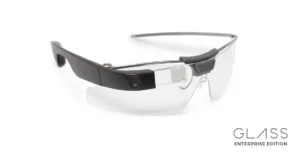Google has confirmed that it has been continuing development of its Google Glass product and has an Enterprise Edition that it will sell to businesses. Google has been working with companies such as GE which claims to have seen an 8% to 12% improvement in engine assembly operations using the Glass and software from Upskill. AGCO, an agricultural machinery maker, said that it had increased assembly productivity by up to 25%, while DHL has seen 15% improvement.
In a less obvious application, doctors at Dignity Health have been using Glass with an application from Augmedix calls “a remote scribe”. Now, instead of typing on a computer during consultations, they can connect with patients by looking them in the eye, listening as they talk, and asking questions — all with confidence that all the note taking work is being done in the background. Dignity’s Chief Medical Information Officer, Dr. Davin Lundquist says that in addition to improving their quality of care, Glass has also reduced the time they spend typing up patient notes and other administrative work from 33% of their day to less than 10%, while doubling the amount of time they interact with patients.
In total, Google said that it continues to work with fifty companies including AGCO, DHL, Dignity Health, NSF International, Sutter Health, Boeing and Volkswagen. The Glass product will be offered through a partner network.
Google said that it has made the design more comfortable as well as increasing the power and battery life (improved from five to eight hours). The camera goes up from 5 MP to 8, and the electronics have been made detachable to work better with prescription or safety glasses. A Google partner quoted €1500 as the kind of price it would charge.
Analyst Comment
We couldn’t find any details of the display used in this edition, but will keep looking. It’s hard to believe that Google hasn’t improved it since the first version. It has been clear for some time that the key early market for AR has been in the enterprise and so it’s no surprise that Google has continued development. It has done a phenomenal job of keeping it quiet, though, despite the wide range of suppliers and users involved. (BR)

